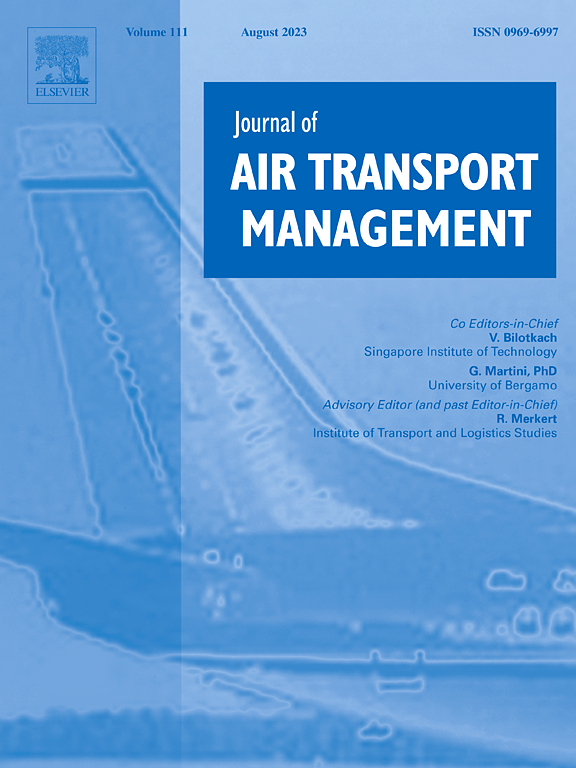Unraveling endogeneity in seat capacity and Fares: Time series econometric models for airline origin-destination passengers forecasting
IF 3.6
2区 工程技术
Q2 TRANSPORTATION
引用次数: 0
Abstract
Accurate prediction of origin-destination (O-D) air travel passengers is critical for airline schedule profitability analysis, as it enables airlines to align capacity with demand, optimize fare structures, and minimize operational inefficiencies. Reliable forecasts also support strategic decision-making by identifying profitable routes, reducing overcapacity risks, and enhancing network connectivity. This study explores the role of seat capacity and fares in forecasting O-D passengers through the development of three experimental models: the baseline Seasonal Autoregressive Integrated Moving Average (SARIMA), Vector Autoregression (VAR) models with endogenous variables, and SARIMAX models with exogenous variables. The models are applied to two O-D pairs, LAX-JFK and IST-LHR, and extended to a larger sample of 2000 O-D pairs for more comprehensive analysis. Results reveal that treating seat capacity and fares as exogenous variables significantly improves forecasting accuracy of passengers, with the SARIMAX models outperforming the VAR models, which incorporate these variables as endogenous factors. The findings suggest that seat capacity is best modeled as an exogenous variable, consistent with airlines’ scheduling practices, where seat capacity may vary across different scheduling periods. This study contributes to the literature by providing insights into the complex relationships between seat capacity, fares, and passengers, while offering a scalable approach for forecasting across large airline networks.
座位容量和票价的内生性:航空公司始发目的地乘客预测的时间序列计量模型
准确预测始发目的地(O-D)航空旅行乘客对航空公司时刻表盈利能力分析至关重要,因为它使航空公司能够根据需求调整运力,优化票价结构,并最大限度地减少运营效率低下。可靠的预测还可以通过确定有利可图的路线、减少产能过剩风险和增强网络连通性来支持战略决策。本研究通过建立季节自回归综合移动平均(SARIMA)模型、内生变量向量自回归(VAR)模型和外生变量SARIMAX模型三种实验模型,探讨客座量和票价在客流量预测中的作用。该模型应用于LAX-JFK和IST-LHR两对O-D对,并扩展到2000对O-D对的更大样本,以进行更全面的分析。结果表明,将座位数和票价作为外生变量显著提高了乘客预测的准确性,且SARIMAX模型优于将其作为内生因素的VAR模型。研究结果表明,座位容量最好作为一个外生变量建模,与航空公司的调度实践一致,其中座位容量在不同的调度期间可能会有所不同。本研究通过深入了解座位容量、票价和乘客之间的复杂关系,同时为大型航空公司网络的预测提供了可扩展的方法,从而对文献做出了贡献。
本文章由计算机程序翻译,如有差异,请以英文原文为准。
求助全文
约1分钟内获得全文
求助全文
来源期刊

Journal of Air Transport Management
TRANSPORTATION-
CiteScore
12.40
自引率
11.70%
发文量
97
期刊介绍:
The Journal of Air Transport Management (JATM) sets out to address, through high quality research articles and authoritative commentary, the major economic, management and policy issues facing the air transport industry today. It offers practitioners and academics an international and dynamic forum for analysis and discussion of these issues, linking research and practice and stimulating interaction between the two. The refereed papers in the journal cover all the major sectors of the industry (airlines, airports, air traffic management) as well as related areas such as tourism management and logistics. Papers are blind reviewed, normally by two referees, chosen for their specialist knowledge. The journal provides independent, original and rigorous analysis in the areas of: • Policy, regulation and law • Strategy • Operations • Marketing • Economics and finance • Sustainability
 求助内容:
求助内容: 应助结果提醒方式:
应助结果提醒方式:


